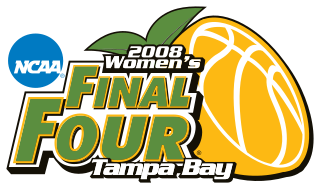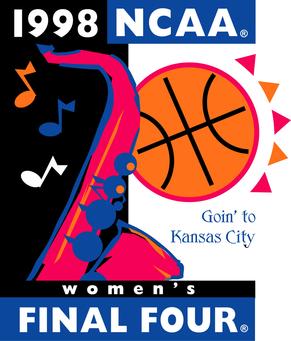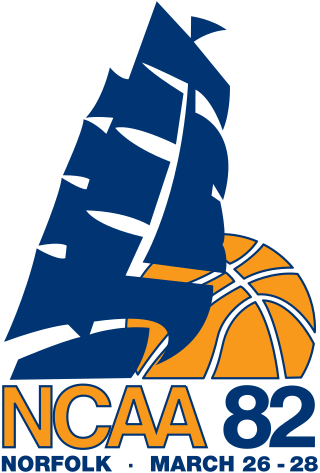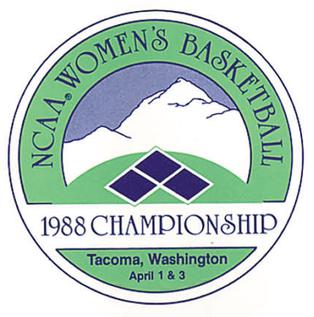
The NCAA Division I women's basketball tournament, sometimes referred to as Women's March Madness, is a single-elimination tournament played each spring in the United States, currently featuring 68 women's college basketball teams from the Division I level of the National Collegiate Athletic Association (NCAA), to determine the national championship.

Tara Ann VanDerveer is a retired American basketball coach who was the head women's basketball coach at Stanford University from 1985 until her retirement in 2024. Designated the Setsuko Ishiyama Director of Women's Basketball, VanDerveer led the Stanford Cardinal to three NCAA Women's Division I Basketball Championships: in 1990, 1992 and 2021. She stepped away from the Stanford program for a year to serve as the U.S. national team head coach at the 1996 Olympic Games. VanDerveer is the 1990 Naismith National Coach of the Year and a ten-time Pac-12 Coach of the Year. She is also one of only nine NCAA Women's Basketball coaches to win over 900 games, and one of ten NCAA Division I coaches – women's or men’s – to win 1,000 games. VanDerveer was inducted into the Women's Basketball Hall of Fame in 2002. On December 15, 2020, she passed Pat Summitt for most wins in women's college basketball history. On January 21, 2024, she won her 1,203rd game as a head coach, becoming the head coach with the most wins in college basketball history, women’s or men’s.

The 2005 NCAA Division I women's basketball tournament began on March 19, 2005, and concluded on April 5, 2005, when Baylor was crowned as the new national champion. The Final Four was held for the first time at the RCA Dome in Indianapolis, Indiana on April 3 and 5, 2005, and was hosted by Butler University and the Horizon League. Future Final Fours will be held every five years in Indianapolis, the NCAA's home city, will be played at Lucas Oil Stadium, one block south of the Indiana Convention Center, where the RCA Dome is located. Baylor, coached by Kim Mulkey-Robertson, defeated Michigan State, coached by Joanne P. McCallie, 84–62 in the championship game. Baylor's Sophia Young was named Most Outstanding Player. For the first time, taking a page from the Men's Tournament, the regionals were named after the city they were played in, rather than the geographical location, and the "pod" system adopted by the Men's Tournament was used.

The 2008 NCAA Division I women's basketball tournament involved 64 teams playing in a single-elimination tournament to determine the 2007–08 national champion of women's NCAA Division I college basketball. It commenced on March 22, 2008, and concluded when the University of Tennessee Lady Volunteers defeated the Stanford University Cardinal 64–48 on April 8, 2008, at the St. Pete Times Forum in Tampa, Florida.

The 1999 NCAA Division I women's basketball tournament began on March 12, 1999, and concluded on March 28, 1999, when Purdue won its first national championship in any women's sport. The Final Four was held at the San Jose Arena in San Jose, California, on March 26–28, 1999. Purdue defeated Duke 62-45 in Carolyn Peck's final game as head coach for the Boilermakers. She had previously announced her intention of leaving Purdue after two seasons to coach the expansion WNBA Orlando Miracle.

The 2010 NCAA Division I women's basketball tournament started Saturday, March 20, 2010, and was completed on Tuesday, April 6 of the same year with University of Connecticut Huskies defending their title from the previous year by defeating Stanford, 53–47.

The 1998 NCAA Division I women's basketball tournament began on March 13, 1998, and concluded on March 29, 1998, when Tennessee won the national title. The Final Four was held at Kemper Arena in Kansas City, Missouri, on March 27–29, 1998. Tennessee, Louisiana Tech, NC State, and Arkansas qualified for the Final Four. Tennessee and Louisiana Tech won their semi-final Final Four matchups and continued on to the championship. Tennessee defeated Louisiana Tech 93–75 to take their sixth title, and complete an undefeated season (39–0).

The 1982 NCAA Division I women's basketball tournament was the first Women's Basketball Tournament held under the auspices of the NCAA. From 1972 to 1982, there were national tournaments for Division I schools held under the auspices of the AIAW. The inaugural NCAA Tournament included 32 teams. Tennessee, Louisiana Tech, Cheyney State, and Maryland met in the Final Four, held at the Norfolk Scope in Norfolk, Virginia and hosted by Old Dominion University, with Louisiana Tech defeating Cheyney for the title, 76-62. Louisiana Tech's Janice Lawrence was named the Most Outstanding Player of the tournament. Her teammate Kim Mulkey went on to become the first woman to win NCAA Division I basketball titles as a player and coach, winning the 2005, 2012, 2019 titles as head coach at Baylor and the 2023 title at LSU..

The 1983 NCAA Division I women's basketball tournament began on March 18 and concluded on April 3 with USC winning the title. The tournament consisted of 36 teams. The Final Four was held in Norfolk, Virginia and consisted of USC, Louisiana Tech, Old Dominion, and Georgia. USC's Cheryl Miller was named the Most Outstanding Player of the tournament.

The 1984 NCAA Division I women's basketball tournament began on March 16 and ended on April 1. It featured 32 teams, four fewer than the previous year. Tennessee, Louisiana Tech, Cheyney, and Southern California were the Final Four, with Southern California defeating Tennessee, 72-61, for its second straight title. USC's Cheryl Miller was named the Most Outstanding Player of the tournament. The semi-finals and finals were held in Pauley Pavilion on the campus of UCLA in Los Angeles, California.

The 1985 NCAA Division I women's basketball tournament began on March 14 and ended on March 31 and featured 32 teams. The Final Four consisted of Old Dominion, Northeast Louisiana, Western Kentucky, and Georgia, with Old Dominion defeating Georgia, 70–65 in the championship game. Old Dominion's Tracy Claxton was named the Most Outstanding Player of the tournament.

The 1986 NCAA Division I women's basketball tournament began on March 12 and ended on March 30. The tournament expanded to 40 teams from 32. The Final Four consisted of Texas, Tennessee, Western Kentucky, and USC, with Texas defeating Southern California, 97-81 in the championship game. Texas's Clarissa Davis was named the Most Outstanding Player of the tournament. With their championship win, Texas completed the first undefeated season (34-0) since the NCAA began sponsoring women's basketball in 1982.

The 1988 NCAA Division I women's basketball tournament began on March 16 and ended on April 3. The tournament featured 40 teams. The Final Four consisted of Long Beach State, Auburn, Tennessee, and Louisiana Tech. Louisiana Tech won its second title with a 56-54 victory over Auburn. Louisiana Tech's Erica Westbrooks was named the Most Outstanding Player of the tournament.

The 1990 NCAA Division I women's basketball tournament began on March 11 and ended on April 1. The tournament featured 48 teams. The Final Four consisted of Virginia, Stanford, Auburn, and Louisiana Tech, with Stanford defeating Auburn 88-81 to win its first NCAA title. Stanford's Jennifer Azzi was named the Most Outstanding Player of the tournament.

The 1991 NCAA Division I women's basketball tournament began on March 13 and ended on March 31. The tournament featured 48 teams. The Final Four event was hosted by the University of New Orleans, and held at the Lakefront Arena in New Orleans. The Final Four teams consisted of Tennessee, Stanford, Connecticut, and Virginia, with Tennessee defeating Virginia 70-67 (OT) to win its third NCAA title. Virginia's Dawn Staley was named the Most Outstanding Player of the tournament.

The 1995 NCAA Division I women's basketball tournament featured 64 teams. The Final Four consisted of Connecticut, Tennessee, Stanford, and Georgia. Connecticut defeated Tennessee 70–64 to win its first NCAA title and complete a 35–0 undefeated season.

The 2016 NCAA Division I women's basketball tournament was played between March and April 2016, with the Final Four played April 3 & 5. The regional locations were four neutral sites: Bridgeport, Connecticut, Dallas, Lexington, Kentucky, and Sioux Falls, South Dakota. The Final Four was played at Bankers Life Fieldhouse in Indianapolis. UConn won their fourth consecutive national championship, defeating Syracuse 82–51.
The Missouri State Lady Bears basketball team represents Missouri State University in NCAA Division I women's basketball. The team has a storied history making 2 NCAA Final Fours, reaching 17 NCAA Tournaments, and claiming 13 conference regular season titles. The Lady Bears compete in the Missouri Valley Conference.
The 1991–92 Southwest Missouri State Lady Bears basketball team represented Southwest Missouri State University during the 1991–92 NCAA Division I women's basketball season. The Lady Bears, led by fifth-year head coach Cheryl Burnett, played their home games at Hammons Student Center and were members of the Gateway Collegiate Athletic Conference.
The 1991 NCAA Division I women's basketball championship game was the final game of the 1991 NCAA Division I women's basketball tournament. It determined the champion of the 1990–91 NCAA Division I women's basketball season and was contested by the Virginia Cavaliers and the Tennessee Lady Volunteers. The game was played on March 31, 1991, at Lakefront Arena in New Orleans, Louisiana. After leading 27–26 at halftime, No. 4 Tennessee needed an overtime period to defeat No. 2 Tennessee 70–67 to capture the NCAA national championship, and bring home the third NCAA championship in program history. Despite the runner-up finish, Virginia's Dawn Staley was named the tournament's Most Outstanding Player (MOP). Staley is the only women's player to be named MOP while not playing for the championship team.




















